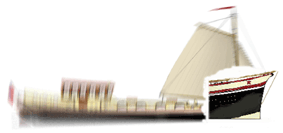 |
|
 |
|
 |
Bathroom <> Build-Story <> Cloakroom <> Deck-Area <> Drive-Steering <> Electrics-Room <> Engine-Room <> Hallway <> Kitchen/Galley <> Lounge/Saloon <> Master-Bedroom <> Rear-Storage <> Spud-Leg <> Study/Bedroom <> Tech-Specs <> Wheelhouse |
|
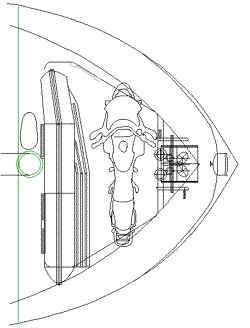 |
JENAL is an altogether different proposition, large by live-aboard standards but small by working barge sizes - 100 tonnes potential carrying capacity - compared to upwards of 3,000 tonnes capacity for today's commercial load haulers. These working barges stick to Europe's big commercial canals JENAL by comparison, will wander through countryside waterways where we encounter quaint low bridges. A deck stored car would only be a height restriction - plus an unsightly encumbrance. | ||||||||
|
Barges by their very nature can't have an attached garden shed or garage next door. Although it is not uncommon for large European working barges to carry a car parked on their deck giving the bargee the opportunity to drive home when his working trip is complete. They simply lift the car on & off with the barges loading derrick or hoist. |
||||||||||
s.jpg) |
For space and packaging reasons we discounted four wheels in favour of two - a 900cc classic Italian Benelli motorcycle. In addition we have other methods of transportation which include mountain bicycles & a Silver Marine RIB (rigid inflatable boat). The bike is our long-distance road transport while the bicycles are our local shopping and discovery tools (plus they'll help keep our physical fitness in check). The Silver Marine RIB will act as JENAL's tender & sea-going liferaft as well as offer some open water-sports fun. We will also use the RIB to explore smaller rivers and generally enjoy those out-of-reach places. |
 |
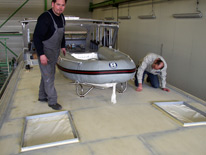 |
The
RIB has always been a key part of the JENAL programme for two
rather important reasons:
The easily collapsible stainless steel frame on the right will hold the RIB on the deck or quayside as needed. |
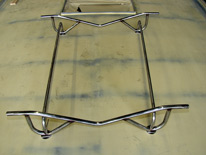 |
||
Built into the dividing steel wall (bulkhead) between the bow-locker and the master bedroom is a 350mm diameter vertical tube placed centrally in line with the bow. This is the forward spud-leg or pin-anchor and runs the full height of the barge from roof to hull bottom. Its second function is to support the otherwise over stressed superstructure area where the mast mounts.
The forward most part of the locker will also house the anchor chains. Known, not surprisingly, as the chain locker, it is a water-tight area where the meters upon meters of recently raised anchor chain can drain into the bilges and be automatically pumped overboard.
|
This illustration (on right) does little visual justice to the end product, a 7 meter mast with cross forms near the top, made form steel and cleverly painted to look like wood. Hydraulics drive the mast from horizontal deck rest to the vertical. Like the wheelhouse, the mast hydraulics will assist in quickly lowering the mast when negotiating low bridges. |
 |
Hydraulic
motors drive the cable winch while hydraulics rotate the base turntable, allowing ease of
pivoting the loaded mast from bow store to quayside or waterside. The mast design is of the GAFF style and reminiscent of the 1800's rigging design where the sail has a squared off top section, reducing its height but offering more sail area in its main cloth. The advantage of this system negates the need to add ugly lifting arms to a barges deck and spoiling her lines. |
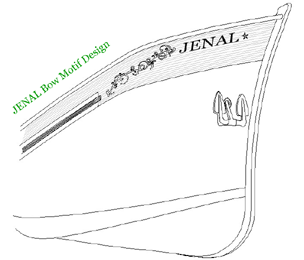 |
Traditional
Dutch Klipper's have mostly been adorned with motifs on their bow,
signifying a bow-wave in a subtle sort of way. Folklore has it that the
illustrations were there to show that the Klipper was a sea going vessel,
marking her out as superior, from the canal only craft. JENAL has sea pretensions and her owners wanted to follow tradition so Alan designed in CAD the motif you see on the left. These are handed (starboard side illustrated) and made in hard-wearing vinyl with a 9mm wide outline (175cm long) in Ivory to match the superstructure colours. |
 |
| HOME <> SITE MAP <> CONTACT US <> ABOUT US <> PUBLIC PRESENTATIONS <> JENAL DIARY <> SUPPLIER CONTACTS <> DUTCH BARGE ASSOCIATION |